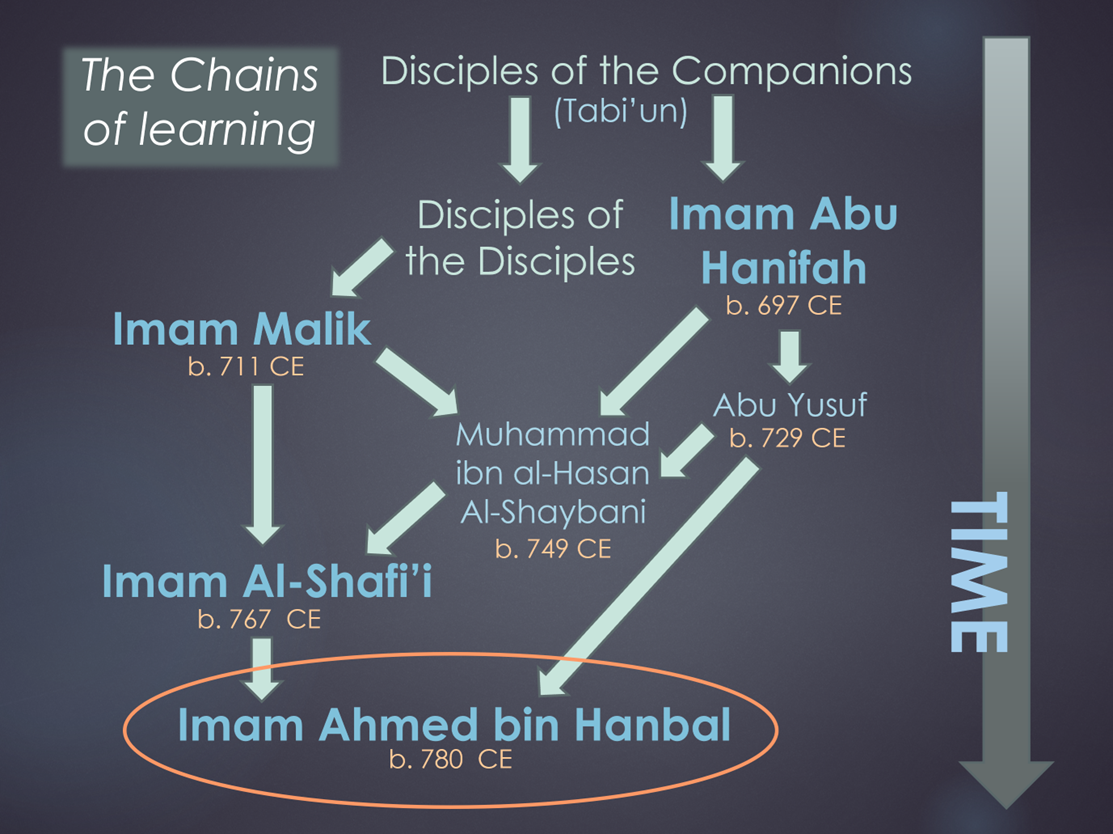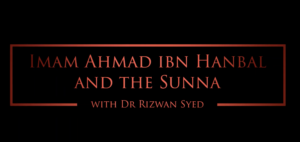Contents
Introduction
This article is best read alongside the article, “Choosing a scholar”.
Prefer lectures to articles? Watch the video of this article & view the timestamps to jump to specific chapters:
Timestamps
12:02 – 22:44
Recap of the previous imams
22:43 – 34:18
Who was Imam Ahmed – why is he well known?
34:17 – 40:45
What were the chains of learning leading from the Prophet (S) to Imam Ahmed?Why was he persecuted?
40:43- 46:09
What were the fiqh principles of Imam Ahmed?
What were his opinions on difference of opinion?
46:08 – 51:00
What is the difference in how the four imams dealt with new problems?
Video Chapter (22:43 – 34:18)
1. Who was Imam Ahmed – why is he well known?
Imam Ahmed bin Hanbal (780-855CE / 164-241 AH)
- Founder of one of the four popular Sunni schools of law – the Hanbali madhab
- Very popular and venerated for his piety and closeness to the other saintly men and women.
- Exceptional memory and intelligence, memorised the books of scholars
- Born in Baghdad, he had his initial education under Imam Abu Yusuf, the student of Abu Hanifah, and Chief Justice of the Abbasid Empire
- Sought knowledge from a great many prominent scholars
- He was primarily a scholar of hadith and spent most of his life collecting and sifting through hadith. From two hadith collectors alone (Bahz ibn Asad and ‘Affan) he wrote down 300,000 hadiths.
- Collated hadith into the Musnad – 27,000 sifted out of 600,000 (completed by his son, ‘Abdullah)
- Not all authentic (sahih) but wanted to preserve any hadith that had a good chance of being associated with the Prophet (S)
- So he did not include hadith he knew to be very weak or fabricated
- Had a preference for recording hadith used to substantiate rulings, i.e. of practical value
- Later studied under Imam Shafi’i becoming a scholar of fiqh but blended this with his extensive expertise in hadith
- He felt it was better to follow what the Prophet probably taught rather than speculate with too much reasoning

2. His Piety and Standing
Imam Shafi’I said: “Ahmed bin Hanbal was a leading scholar in many fields: in hadith, in fiqh, in Qur’an, in asceticism (saintly self-denial), in piety and in knowledge of the sunnah”
‘Abdul Malik Al Maymuni used to say: “My eyes never saw anyone better than Ahmed bin Hanbal and I have never seen anyone among the scholars of hadith who shows more respect for the sacred limits of Allah and the sunnah of His Prophet, if a report is proven to be sahih. And I have never seen anyone more keen to follow the sunnah than him.”
Al Mawardhi said, “I said to Ahmed: ‘How are you this morning?’; He replied: ‘How would anyone be whose Lord is demanding that he carry out the obligatory duties, and his Prophet is demanding that he follow the Sunnah, and the two angels are demanding he mend his ways, and his nafs is demanding that he follow its whims and desires, and Iblees is demanding that he commit immoral actions, and the angel of death is watching and waiting to take his soul and his dependents are demanding that he spend on their maintenance?”
Questions:
What were the chains of learning leading from the Prophet (S) to Imam Ahmed?
Why was he persecuted?
Video Chapter (34:17 – 40:45)
3. Persecution
- Caliph Al Ma’mun, the son of Harun Al Rashid is famous for his interest and support for the learning of other civilisations, especially the Greeks and his setting up the House of Wisdom in Baghdad. Here, scholarship in all fields was generously supported.
- Few people are perfect and one of the darker sides of Al Ma’mun’s character was him launching an inquisition – called the Mihna, to ensure that a philosophical interpretation of Islam was taught across the empire (Mu’tazili doctrine)
- Imam Ahmed, refusing to accept his philosophies about the creation of the Qur’an, was thus imprisoned and tortured by Al Ma’mun – ordering 150 floggers to each flog him with two lashes.
- He remained in prison during the reign of two Caliphs before eventually being freed in response to popular outrage.
- Imam Adh-Dhahabi described Ibn Hanbal as, “The true Shaykh of Islam and leader of the Muslims in his time, the master of hadith and proof of the religion.”
Questions:
What were the fiqh principles of Imam Ahmed?
What were his opinions on difference of opinion?
Video Chapter (40:43- 46:09)
4. The Fiqh Principles of Imam Ahmed
He followed the general approach of Imam Shafi’I but felt that reasoning was so risky that even if a slightly weak hadith could address the problem, he would prefer to go with that – hence his efforts to collate such hadith in the Musnad.
Imam Ibn al Qayyim (a later Hanbali scholar) described the main foundation on which Imam Ahmed based his rulings (fatwas):
- The texts (Qur’an and hadith)
- Then the fatwas of the Sahabah
- Then selecting one of the views of the Sahabah, in case they differed on an issue
- Then following a mursal (chain has sahabah missing) or da’eef hadith – which in his view were valid and were a category of hasan hadiths.
- Then if he did not find any (of the above), he would resort to the fifth option, which is analogy, and he would use it (only) when necessary.
5. On Difference of Opinion
According to later notable scholars of the Hanbali school like Ibn Aqil and Ibn Taymiyyah, Ibn Hanbal “considered every madhhab correct and abhorred that a jurist insist people follow his even if he considered them wrong and even if the truth is one in any given matter.”
When Ibn Hanbal’s student Ishāq ibn Bahlūl al-Anbārī had “compiled a book on juristic differences … which he had named The Core of Divergence (Lubāb al-Ikhtilāf),” Ibn Hanbal advised him to name the work The Book of Leeway (Kitāb al-Sa’a) instead.
Gibril F. Haddad, The Four Imams and Their Schools (London: Muslim Academic Trust, 2007), pp. 306 and 313; see Ibn Taymiyyah, Majmū’ al-Fatāwā, 20:365
Question:
What is the difference in how the four imams dealt with new problems?
Video Chapter (46:08 – 51:00)
6. Dealing With New Problems
If new problems occurred:
Imam Malik would have considered any laws that help the public part of shari’ah (maslahah mursalah). This would involve assessment of the best evidence of what benefits the public, and this would be endorsed.
If there was a hadith that applied to a similar situation but following it would cause hardship, then Imam Malik may not follow it, as the greater sunnah was that Islam came to benefit people.
The Hanafis established principles that would embrace new situations, so that Islamic teachings could extend into new contexts, even if the Prophet (S) had not specifically ruled on those situations.
Where the matter does not encroach on important areas of Divine Law, the Hanafis would endorse local custom (‘Urf) for their judgements.
Unlike other madhabs, Hanafis devised rules for taxation, foreign policy and other spheres of government and the Hanafi madhab was preferred by most large empires.
Imam Shafi’i’s approach was to look for something in the hadith that was very similar to the new problem and analogise a ruling (qiyas Jali / manifest analogizing)
Completely new problems for which there was no precedent in the hadith, should be dealt with by the authorities and people would have to follow the law, but considered such things outside the scope of Shari’ah. So to not follow the law of the land will get you into trouble with the authorities but may not be a spiritual sin as such.
The Hanbali approach to new problems would be to look for a hadith with a reasonable probability of accuracy and apply it even if it doesn’t exactly match the new situation, and even if it caused a degree of hardship, because at least it showed a desire to adhere to the Prophet’s teachings and to avoid thinking too much as that could be even more erroneous.


